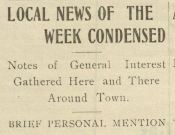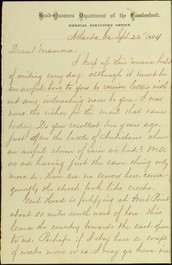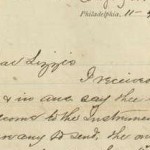Post for: Susan Ottignon, Special Collections and Digital Library Team

Ardmore Chronicle – Volume XVII, No. 29, Saturday, April 13, 1907.
Annotated and transcribed text from the digitized copy in the Historical Society of Montgomery County Collection.
LOCAL NEWS OF THE WEEK CONDENSED
————
Notes of General Interest Gathered Here and There Around Town.
————
BRIEF PERSONAL MENTION
————
Miss Harriet P. Cooper, of Philadelphia, addressed the Missionary Circle of the First Baptist Church Tuesday afternoon.
Secretary C. D. Bruckner, of the local Y. M. C. A., has been spending the last week in Pittsburg.
A cross-country run, open for all Lower Merion High School [1] boys, except last year’s track team, will be held on April 19. The winner will be awarded a gold medal.
The supper and bazaar given in Masonic Hall Tuesday evening by the ladies the Lutheran church was well attended.
Mr. Conrad Sheive, who comes up for renomination as District Attorney of this county at the June primaries, made a brief canvass of Ardmore on Tuesday.
Bert Simpson, of Narberth, who is traveling in the South with the U. P. [2] baseball team, has made a good showing in the pitchers’ box at several of the games.
The local office of the Lower Merion Directory has been established at No. 1 Colonial Block.
A runaway horse and cart belonging to Mr. Charles Frederick, of Ardmore, narrowly missed colliding with the team of Mr. Harry Bicking last Saturday at Wynnewood station.
Four new arc lights, supplied with electricity from the dynamo in the cellar, will be used in the gymnasium of the public school tonight during the musicale given by the High School.
Sam Lung has moved his laundry from the Y.M. C. A. Building to the location formerly Clinton’s barber shop.
Mrs. H. C. Franzen, who has been visiting Mr. Paul J. Kugler and Dr. Anna Kugler, left for her home in Hartford, Conn., this morning.
The members of the Lutheran church are getting ready for the production of “Who’s Next?” a comedy which promises barrels of fun.
The D. T. Society met last Saturday for their fortnightly assembly at the home of Miss Marguerite Goodman, on Simpson road.
Mr. and Mrs. William Mann entertained on Monday at their home, on Aubrey avenue, in honor of Mr. Mann’s birthday.
A Rummage Sale for the benefit of the Ardmore Free Library will be held April 27 to May 4, inclusive, at the old trolley station, Cricket avenue. Donations are solicited. Articles may be sent to the old trolley station during sale, or send a postal to Mrs. D. Bartlett, and they will be called for.
Miss Helen Morley, who has been visiting Miss Mary McGodlrick for the past month, leaves tonight for her home at Youngstown.
St. Denis’ I. C. B. U. [3] will give a euchre and dance in T. A. B. Hall on April 30.
Mr. Henry Kauffman, of Hackensack, N.J., has been the guest of his mother, Mrs. H. Kauffman, of Simpson road, during the week. On Tuesday evening he left for an extended trip to the Pacific Coast.
Miss Jane Cleaver has returned from a visit of several weeks at Huntingdon, Pa.
The seniors of the Lower Merion High School held their second reception last night in the gymnasium.
The Autocar [4] office team played a nine from the shops last Saturday in the first baseball game of the season. The office won, 11-5.
Mrs. F. Alison and family of, Lancaster avenue, removed yesterday to Chestnut Hill, where they will reside.
Mr. Clarence Piper, of Ardmore, after an absence of six months, has returned to work for his former employer, Mrs. John Cameron, of Bryn Mawr.
The prizes for the drawing to be held soon by St. Denis’ T. A. B. Society [5] are: First, $10; second, an umbrella; third, a suitcase; fourth, a pair of shoes made to order.
Dr. J. Howard Cloud has taken up permanent residence on Lancaster avenue, in the property recently purchased by him, and which was occupied by Mrs. Alison.
Miss Helen Condrick hasreturned [sic] from Pennsville, N. J., where she was visiting friends.
The baggage stand at the Ardmore station is being enlarged by a 20-foot extension.
The work of enlarging the store of the Elborn Hardware Company has been going on all week.
Rev. F. W. Staley spent part of the week in Harrisburg.
Don’t forget the lecture in St. Paul’s Lutheran Church next Thursday night, on “An Hour’s Ride With General Phil Sheridan.
The Christian Endeavor Society of the Baptist church of Ardmore held a business meeting and social at the residence of Mrs. J. E. Bourne on Tuesday evening.
Charley Cassell, of Ardmore, who was to have been tried out for the Ardmore baseball team, received an offer from Cornell University, and he left for Ithaca on Tuesday morning. He will try “pitching” his way through college.
The Hayloft of Blue Jacket Tribe, 395½, Imp. O. R. M. [6], full regalia, paid a visit to Manoa Tribe on Thursday evening. They had “a large time.”
A number of Ardmore people attended the T. A. B. dance at Rosemont on Thursday night.
————–
1. “Ruins of the Ardmore Public School (1900) — Photograph.” Collection: W. Robert Swartz. Lower Merion Historical Society Archives. Accessed 11 March 2014. <http://www.lowermerionhistory.org/photodb/web/html2/138-1.html>
2. University of Pennsylvania.
3. Irish Catholic Benevolent Association.
4. “Autocar in Lower Merion.” By David Schmidt, Special to Main Line Life. The Lower Merion History Society. Copyright © Lower Merion Historical Society. Accessed 11 March 2014. <http://lowermerionhistory.org/dev/sample-page/full-text-resources/david-j-schmidt-collection/278-2>
5. Temperance — Societies, etc.
6. ” . . . The fraternity traces its origins back to 1765 and is descended from the Sons of Liberty. . . ” The Improved Order of Red Men. Content © 1998-2014 The Improved Order of Red Men. All rights reserved. Accessed 11 March 2014. <http://redmen.org/redmen/info/>










